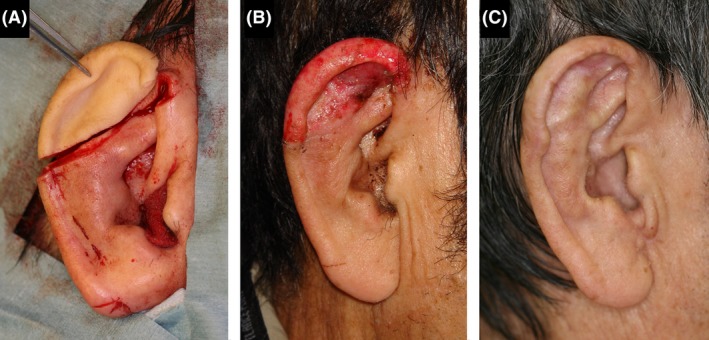Abstract
We report a case of successful microsurgical reattachment of an amputated ear. Microsurgical reattachment should be considered whenever possible.

Dear Editor,
Ear amputation is a rare facial trauma,1 and reconstruction is challenging because it is difficult to restore the original appearance of the ear. Appropriate primary management is indispensable for a good outcome. We report a case of successful microsurgical reattachment of an amputated ear.
A fall into a glass fish tank caused the clean amputation of the upper third of the right ear of a 62‐year‐old man (Fig. 1A). The amputated ear had been preserved in gauze within a plastic bag containing ice cubes. The time between the injury and arrival was 2 h. The ear was reattached with the patient under general anesthesia in the right lateral position. Approximately 1 cm of skin was dissected along the helix of the ear. An artery of appropriate diameter was identified in subcutaneous tissue and anastomosed microsurgically using 11‐0 nylon. No vein appropriate for microsurgical anastomosis was identified. After microvascular clumps were released, reperfusion of the ear was favorable. The auricular cartilage was sutured using 5‐0 polydioxanone; the skin was sutured with 5‐0 nylon. The total operative time was 2 h 23 min; ischemia time was 5 h. Mild blood congestion occurred after the surgery (Fig. 1B), but gradually disappeared by 4 weeks after surgery. One year after reattachment, the appearance of the ear was nearly normal (Fig. 1C).
Figure 1.

A, Preoperative view showing clean amputation of the upper third of the right ear of a 62‐year‐old man who fell into a glass fish tank. B, Three weeks after surgery, the replanted ear shows signs of venous congestion. C, One year after surgery the ear has a good contour and color match.
This case highlights two important clinical issues. First, microsurgical reattachment achieved excellent functional and esthetical results. Ear amputation is not a life‐threatening injury, but the esthetic outcome tends to be unfavorable without proper initial management. Ears are functionally important because they are essential for wearing masks or glasses. Secondary reconstruction of amputated ears is quite difficult to accomplish while maintaining good facial contours. Although various non‐microsurgical methods have been used for reconstruction for amputated ears, they have disadvantages of shape and color mismatch.1, 2, 3 Therefore, microsurgical reattachment should be considered whenever possible.
Second, venous anastomosis is desirable but not essential for the survival of reattached ears.4 If possible, vein repair should be attempted to avoid complications subsequent to venous congestion.5 Identifying veins in amputated ears is challenging because the diameters of appropriate vessels are only 0.3–0.6 mm, and bleeding from veins stops easily compared with arteries. However, even if no veins are identified, successful microsurgical reattachment may be possible. A review of 37 published cases of microsurgical repair found that venous repair was impossible in 14 cases and reattachment was successful in eight.1 Even if the reattachment failed, secondary ear reconstruction using autogenous cartilage was possible. The possibility of arterial revascularization is the minimum requirement for reattachment of amputated ears.
In conclusion, microsurgical reattachment was a successful treatment option for this amputated ear, with favorable cosmetic and functional outcomes. Arterial revascularization may be sufficient for successful reattachment when venous anastomosis is impossible.
Conflict of interest
None Declared.
References
- 1. Steffen A, Katzbach R, Klaiber S. A comparison of ear reattachment methods: a review of 25 years since Pennington. Plast. Reconstr. Surg. 2006; 118: 1358–64. [DOI] [PubMed] [Google Scholar]
- 2. Lin PY, Chiang YC, Hsieh CH, Jeng SF. Microsurgical replantation and salvage procedures in traumatic ear amputation. J. Trauma 2010; 69: E15–9. [DOI] [PubMed] [Google Scholar]
- 3. Jung SN, Yoon S, Kwon H, Yim YM. Successful replantation of an amputated earlobe by microvascular anastomosis. J. Craniofac. Surg. 2009; 20: 822–4. [DOI] [PubMed] [Google Scholar]
- 4. Kind GM. Microvascular ear replantation. Clin. Plast. Surg. 2002; 29: 233–48. [DOI] [PubMed] [Google Scholar]
- 5. Talbi M, Stussi JD, Meley M. Microsurgical replantation of a totally amputated ear without venous repair. J. Reconstr. Microsurg. 2001; 17: 417–20. [DOI] [PubMed] [Google Scholar]


